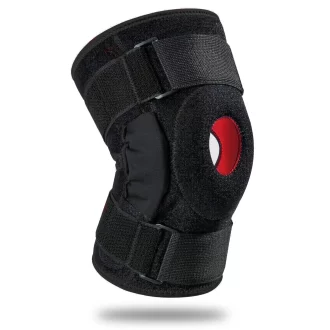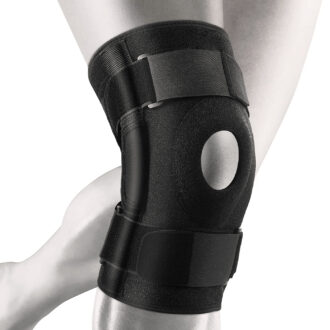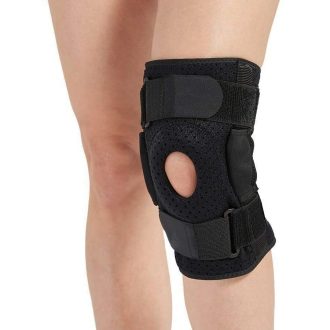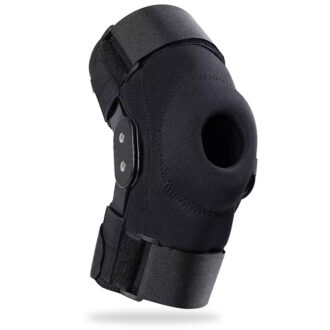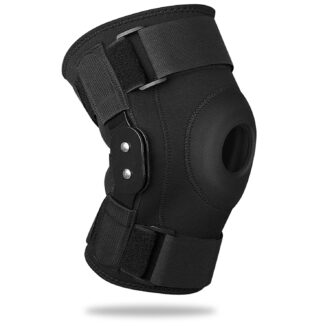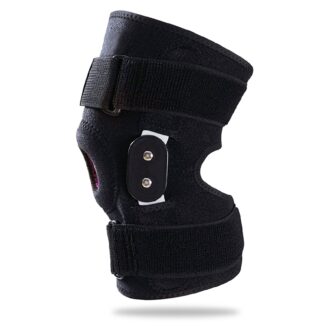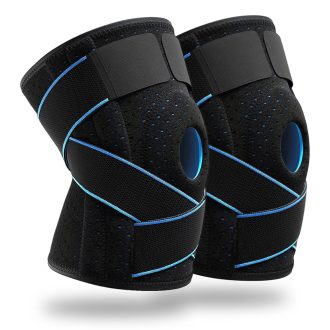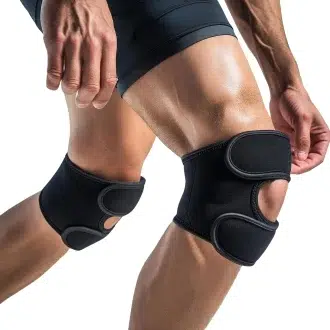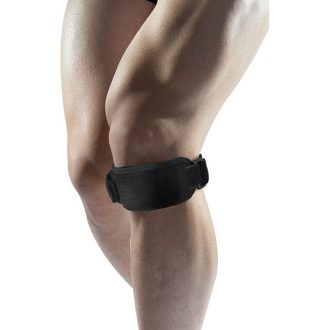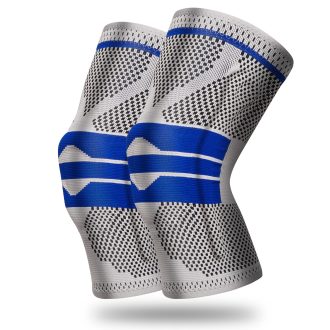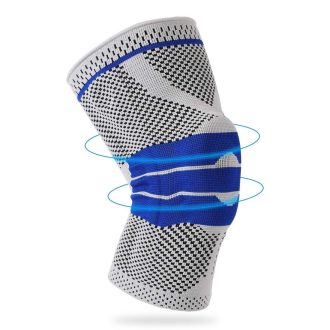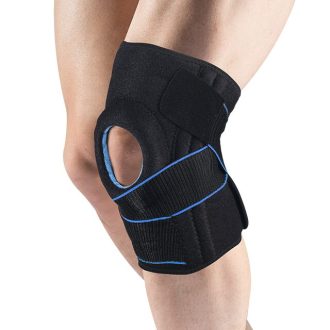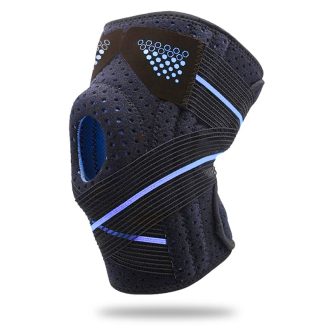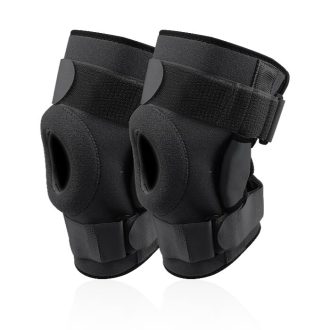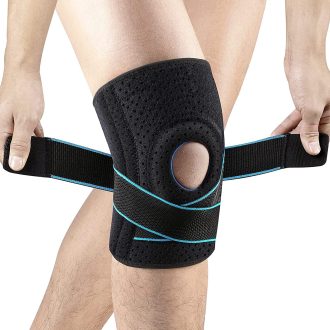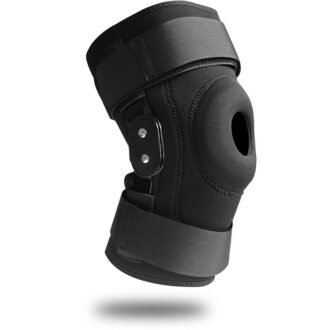No products in the cart.
Knee Supports
Best knee supports & braces to buy
If you’re suffering from knee pain or injury, you know how debilitating it can be. Even simple activities like walking up stairs, bending down, or enjoying your favorite sport can become a challenge. Knee pain not only disrupts your daily activities but also significantly diminishes your overall quality of life, leaving you feeling frustrated and limited.
The Solution: Our Range of Professional Knee Supports
When it comes to knee health, NuovaHealth has you covered. Our knee supports are designed to significantly improve and accelerate your recovery, as well as protect your knees from future injuries. Explore our comprehensive range, including Compression Sleeves, Hinged Braces, Stabilizers, and Splints. Each product is meticulously crafted with unique features to support and protect your knee joint, ease your pain, and enhance your mobility.
- Targeted Compression
Many of our knee supports, such as Compression Sleeves and Stabilizers, feature targeted compression technology. This advanced design helps alleviate pain and speeds up recovery by stimulating the muscles around your knee joint and improving blood flow. Enhanced blood circulation promotes natural healing, reduces inflammation, and eases discomfort, allowing you to get back on your feet faster.
- Orthopaedic Support
With options like Hinged Braces and Splints, you benefit from cutting-edge orthopaedic technology. These supports alleviate pressure on key ligaments and tendons, such as the Anterior Cruciate Ligament (ACL). By stabilizing your knee joint and improving patella tracking, they prevent movements that could lead to further injury. This means a faster, more comprehensive recovery without additional strain.
- Shock Absorption and Stabilization
Our supports, including Stabilizers and Hinged Braces, are crafted from medical-grade, shock-absorbing materials. These materials protect your ligaments, tendons, and bones from shocks and jolts, crucial for preventing conditions like Runner’s Knee and Arthritis. This protection ensures your knee is safeguarded during recovery, allowing you to move with confidence and ease.
- Comfortable Materials
One often overlooked yet essential feature in a quality knee support is the use of breathable comfortable materials. Our supports are designed with advanced, moisture-wicking fabrics to keep your skin dry and comfortable. This feature is crucial for long-term wear, preventing skin irritation and ensuring you can keep your support on for extended periods without discomfort. For instance, our Compression Sleeves utilize this breathable fabric to offer a snug fit without causing excessive sweating.
- Fully Adjustable
Another important feature is adjustable straps, which are integrated into many of our knee supports such as Hinged Braces and Stabilizers. These straps allow you to customize the fit to your specific needs, ensuring optimal support and comfort. A perfect fit is vital for effective stabilization and to prevent the support from slipping during activities. For example, our Hinged Braces come with adjustable Velcro straps that make it easy to secure the brace in place, providing consistent support throughout your day.
Our knee supports at NuovaHealth are designed with your well-being in mind. By incorporating these thoughtful features, we aim to help you recover quickly, stay active, and live your best life free from knee pain and discomfort.
Accelerate and Enhance Your Injury Recovery with Our Knee Supports
Our knee supports are widely recommended by health professionals for treating and preventing a variety of knee conditions and injuries including:
Why Choose NuovaHealth For Your Knee Support Needs
At NuovaHealth, your well-being comes first. Every knee is different, so we offer a wide range of supports designed for specific needs—from everyday pain relief to sport and post-injury recovery. From our in-house designs to expert brands like KneeReviver, you get high-quality materials and thoughtful engineering that help stabilize your joint, reduce pain, and support faster recovery.
Our Commitment To Quality And Innovation
Each support is built for optimal compression, stability, and all-day comfort. Durable, breathable, skin-friendly fabrics keep you comfortable, while smart designs help distribute pressure evenly across your knee. Whether you need extra control for activity, cushioning for daily wear, or structured support after injury or surgery, you’ll find a reliable option that fits your life.
Consult A Medical Professional
The right diagnosis leads to the right support. If you have knee pain or a recent injury, speak with a medical professional to identify the cause and get guidance on the best type of brace or sleeve for you. Our team is also here to help—reach out if you’d like advice on choosing the most suitable option.
Our Satisfaction Guarantee
We stand behind every product. All knee supports and braces come with a full 30-day money-back guarantee for your peace of mind. For details, see our returns policy.
Take Action Today
Explore our wide range of knee supports below and take the first step toward more comfortable, confident movement. Reclaim your mobility—NuovaHealth is here to support you every step of the way.
Anterior Cruciate Ligament Injury Knee Brace
- Introducing the Innovative ACL Knee Brace from KneeReviver: This cutting-edge support is designed with recovery in mind, offering targeted compression, robust stabilization, and comprehensive protection for the ACL.
- Support, Stability, and Protection for Your ACL: Equipped with durable hinges on either side, this knee brace provides robust support for the knee joint. These hinges work together to boost stability and control, ultimately helping to prevent further damage to the ACL and knee joint. Why is this so important? With an ACL injury, the knee joint is in a vulnerable state. Extra support alleviates strain and pressure, aiding proper recovery.
- Targeted Compression for Faster Recovery: Another standout feature of this ACL knee brace from KneeReviver is its ability to provide targeted compression. Why is this vital if you have an ACL injury? Compression stimulates blood flow in the knee, speeding up healing by promoting efficient removal of waste products and delivering more oxygen and nutrients to the injury site. It also helps reduce swelling and inflammation, providing welcome relief. It’s like having a comforting hand continually massaging the knee, easing pain and discomfort.
- Recommended for a Wide Range of Conditions: KneeReviver’s brace isn’t only suited for ACL injuries. It’s also perfect for recovery and rehabilitation from many other knee conditions, including MCL and PCL injuries, dislocations, chondromalacia or irritated kneecap, patellar tendonitis, sprains and strains, meniscus tears, gout, arthritis, and knee instabilities.
- Prevention is Better than Cure: This knee brace isn’t just about healing—it’s about prevention, too. Its design prevents twisting and improper movement of the knee joint, protecting against sprains and strains. This can be especially beneficial for an ACL injury, as the knee becomes more susceptible to additional issues. By restricting improper motions, it acts as a safeguard against further complications.
- Features an Inbuilt Silicone Gel Knee Pad: The inbuilt silicone gel knee pad not only provides soothing compression for knee pain but also delivers extra protection for the kneecap and patella tendon. This feature enhances patella tracking, ensuring the knee cap moves correctly during bending and straightening, contributing to a quicker recovery.
- Soft, Skin-Friendly, and Durable – Designed for Comfort: Made from soft, skin-friendly, lightweight, and durable materials, this knee brace helps ensure comfort isn’t compromised. Moisture-wicking and anti-bacterial properties prevent rubbing, chafing, and skin irritation, keeping the knee dry and comfortable—even during extended wear.
- Backed with a Full 30-Day Money-Back Guarantee: KneeReviver is so confident in the quality and effectiveness of this ACL knee brace that it’s backed by a full 30-day money-back guarantee. Satisfaction and a speedy recovery are top priorities.
- Take Control of Recovery: In essence, this Innovative ACL Knee Brace by KneeReviver is designed to provide the control and confidence needed to steer recovery in the right direction. Gradually regain strength and return to favorite activities without the lingering fear of pain or reinjury. Embrace the path to a swift recovery with this ACL Knee Brace.
£15.49inc VATMedical Knee Support Brace for Osgood Schlatter disease
- 1x Medical Knee Support Brace for people suffering from Osgood Schlatter Disease this knee brace has been purposefully designed to help support and ease pressure off your knee joint and prevent knee pain quickly and effectively
- For both Men & Women
- Available in sizes Medium, Large, as well as Plus sizes XL & XXL
- Features Fully Adjustable Velcro Straps (Maximum Circumference Medium: 40cm, Large: 50cm, XL: 60cm, XXL: 70cm) that wrap around your knee and keeps the brace securely in place even during vigorous exercise, running and sports
- Provides targeted support and soothing compression that will help speed up the natural healing process by stimulating blood flow and the supply of fresh oxygenated blood to damaged tissue this will also in turn reduce inflammation and swelling and ease pain deep within your knee joint
- Features 2 removeable metal hinge stabilizers that fit either side of the knee brace which are specially designed to help stabilize and support your knee joint to protect you from movement which could cause strain and injury to your knee
- Ideal for people suffering from painful and deliberating conditions affecting their knees such as Osgood Schlatter disease, Osteoarthritis, Rheumatoid Arthritis, Gout, Runners’ Knee, Chondromalacia or Irritated Knee Cap, Iliotibial Band Syndrome, Knee instabilities or for general aches and pains
- Recommended for use during injury recovery and rehabilitation for knee injuries including Anterior Cruciate Ligament injuries, Medial Collateral Ligament, Patella Tendonitis, Meniscus tears, Meniscitis (cartilage injury) as well as for general sprains and strains
- Made from high quality medical grade materials that are built to last even when wearing the brace consistently to ensure uninterrupted injury rehabilitation and recovery
- Features a silicone gel pad that moulds to the exact shape of your knee helping to protect you from shock and impacts whilst also helping to ease your patella tendon and knee cap
- The breathable design and moisture wicking and lightweight materials that this knee brace has been made from makes it ideal for wearing whilst playing sports, running or for exercise to help prevent injury
- Includes a full 30 day money back guarantee!
£15.49inc VATMeniscus tear Knee Brace
- 1x Hinged Meniscus tear Knee Brace designed to support, compress, stabilize and protect your Meniscus ligament found in your knee joint
- For both Men & Women
- Available in sizes Medium, Large, XL & XXL
- Adjustable straps (Maximum Circumference Medium: 40cm, Large: 50cm, XL: 60cm, XXL: 70cm) help to keep the Meniscus Knee Brace securely in place and prevents rubbing and chaffing
- Recommended for Meniscus tears, Meniscitis (cartilage injury), Anterior cruciate ligament (ACL) injuries, Medial Collateral Ligament (MCL) Injuries, Arthritis, Gout, Chondromalacia, Patellar tendonitis, Sprains & Strains
- Provides targeted support that helps to stabilize, immobilize and supports your knee joint in the correct position helping improve function and prevent excessive strain and pressure from damaging and injuring your knee
- Provides soothing compression to help improve injury recovery and speed up the healing process by easing aches and pains, reducing inflammation and swelling and supplying fresh oxygen rich blood to your knee to help heal damaged tissue
- Silicone gel knee pad soothes and protect your knee cap and patella tendon from shock and impacts and helps improve patella tracking
- Features 2 removable metal hinges that help protect your knee from movement which could cause further damage by spraining, twisting and straining weakened and injured tendons, ligaments, bones and muscles in your knee
- Made from skin-friendly, breathable, lightweight and padded materials with moisture wicking and anti-bacterial properties to protect your knee from shock and impacts whilst keeping your knee dry and comfortable whilst wearing the Meniscus Knee Brace
- Ideal for runners and sports professionals
- Includes a full 30 day money back guarantee!
£15.49inc VATMedical knee brace
- 1x Medical Knee brace support designed to improve post-op and injury recovery
- For both Men & Women
- Available in sizes Medium, Large, including PLUS SIZES XL & XXL for larger leg shapes
- Fully Adjustable straps (Maximum Circumference Medium: 40cm, Large: 50cm, XL: 60cm, XXL: 70cm) keep the knee brace securely in place and prevents rubbing and chaffing
- Recommended by Physiotherapists for treating and easing Anterior cruciate ligament (ACL) injuries, Medial Collateral Ligament (MCL) Injuries, Osgood Schlatter disease, Meniscus tears, Meniscitis (cartilage injury), Patellar tendonitis, Chondromalacia, Sprains, Strains, Arthritis and Gout
- Features 2 removable metal hinged side stabilizers designed to support, immobilizes and hold your knee in the correct position and prevent excessive movement and force from causing further damage to your injured knee as you recover
- Helps strengthen and improves the way your knee functions to help speed up injury recovery and prevent instabilities and future knee injuries from occurring
- Provides targeted compression that helps stimulate circulation to your injured knee to alleviate aches and pain, reduce muscle fatigue, inflammation and swelling and promote healing
- Features a gel knee cap made from the highest grade medical silicone to soothe, protect your knee cap and patella tendon from shock, impacts and vibrations and improve patella tracking to prevent further injuries
- Made from soft padded materials specially designed to absorb sweat and neutralize odour and bacteria to prevent the build up of bacteria, stop infection and keep your knee and leg dry and comfortable
- Can be worn whilst exercising and playing sports to help better support and protect your knee from injury
- Includes a full 30 day money back guarantee!
£15.49inc VATPlus Size Knee Brace
- 1x Hinged Plus Size Knee Brace designed for wider legs to protect, support, compress and keep weight and pressure off your knee joint to help improve injury recovery
- For both Men & Women
- Available in sizes Medium, Large, as well as PLUS SIZES XL & XXL
- Fully Adjustable straps (Maximum Circumference Medium: 40cm, Large: 50cm, XL: 60cm, XXL: 70cm) keep the knee brace securely in place and prevents rubbing and chaffing
- Recommended for Anterior cruciate ligament (ACL) injuries, Medial Collateral Ligament (MCL) Injuries, Meniscus tears, Meniscitis (cartilage injury), Osgood Schlatter disease, Chondromalacia, Patellar tendonitis, Sprains, Strains, Arthritis and Gout
- Features 2x removable metal hinges (includes cover sleeves that can be attached to protect the metal hinges from damage) either side of the knee brace that help improve knee stability and function and prevent movement and excessive pressure from damaging your injured knee joint whilst you are recovering
- Provides soothing compression to boost blood flow to your knee joint to help speed up and improve with your injury recovery by reducing inflammation and swelling, easing aches and pains and promote the natural healing process of damaged tendons, ligaments, muscles and bones
- Inbuilt silicone gel knee pad helps protect your knee cap from shock and impacts, supports your patella tendon in the correct position to help improve patella tracking and stability and soothes aches and pains deep within your knee
- Made from high quality, soft, padded and breathable Neoprene material with moisture wicking and anti bacterial properties to help keep your knee, dry, odour free and comfortable whilst wearing the brace
- Can be worn whilst exercising and playing sports to prevent knee injuries and wear and tear from occurring
- For better comfort whilst wearing the knee brace we also recommend wearing a pair of knee support sleeves that are available here.
- Includes a full 30 day money back guarantee!
£15.49inc VATHinged MCL Knee Brace
- 1x Hinged MCL Knee Brace designed to support, compress, stabilize and protect your Medial collateral ligament to help improve your injury recovery
- For both Men & Women
- Available in sizes Medium, Large, XL & XXL
- Adjustable straps (Maximum Circumference Medium: 40cm, Large: 50cm, XL: 60cm, XXL: 70cm)
- Recommended by Physiotherapists to help treat and prevent a wide range of knee injuries and conditions including Medial Collateral Ligament (MCL) Injuries, Anterior cruciate ligament (ACL) injuries, Meniscus tears, Meniscitis (cartilage injury), Chondromalacia, Patellar tendonitis, Sprains, Strains, Arthritis, and Gout
- Features 2 metal hinged knee stabilizer splints located either side of the knee brace to help support the ligaments, tendons, muscles and bones found within your knee joint and prevent movement and pressure that could twist, sprain and cause injury to your knee
- Provides soothing compression to increase the flow of oxygen rich blood to your knee joint to help promote the healing process of damaged tissue, reduce inflammation and swelling and ease aches and pains
- Helps improve knee function, stability and correct the biomechanical balance of your knee to prevent knee injuries and wear and tear
- Features an inbuilt gel knee pad made from soothing medical grade silicone gel that helps support and protect your knee cap by supporting your patella tendon in the correct position, improves patella tracking and prevents shock and impacts from damaging your knee
- Made from lightweight, breathable, skin friendly and padded Neoprene material designed to keep your knee dry, sweat free and feeling comfortable even if you wear the knee brace for a long period of time
- Includes a full 30 day money back guarantee!
£15.49inc VAT1x Pair of Compression Knee Support Brace Sleeves for Knee pain & injury
- 1x Pair of Compression Knee Support Brace Sleeves for Knee pain & injury
- For both Men & Women
- One size fits most
- Recommended for treating and easing a wide range of knee injuries and conditions including ACL, PCL & MCL knee injuries, Meniscus Tear, Runners & Jumpers knee, Patellar tendonitis, Patellar tendon sprains and strains, Iliotibial Band Syndrome, Chondromalacia or irritated knee cap, Gout, Arthritis, and Osteoarthritis
- Fully adjustable knee wraps allow you to change the level of support, compression and the fit with total ease
- Features inbuilt side stabilizer support springs that have been specially engineered to help give your knees targeted support and will realign your knees into the correct position and ease strain and pressure off them
- Provides soothing compression that boosts blood flow to your knees to aid and speed up the injury recovery process of knee injuries by supplying fresh oxygenated blood to damaged tissue, reducing inflammation and swelling and helps ease aches and pains
- Features gel knee pads made from medical grade silicone that will help improve patella tracking and stability, protect them against shock and impacts and provide soothing pain relief to your knees
- Can be worn whilst running and playing sports to provide extra protection and support and help prevent muscle fatigue your knees
- Made from high quality lightweight, breathable and durable materials with ventilation holes and moisture wicking properties to help keep your knees sweat free, dry and feeling fresh and comfortable
- For the best possible comfort we recommend wearing these knee braces with a pair of knee support sleeves which are available here.
- Includes a full 30 day money back guarantee!
£25.98£29.98inc VAT1x Pair of ITB Strap Knee braces for Iliotibial Band Syndrome
- 1x ITB Strap Knee brace for helping to treat, ease and prevent Iliotibial Band Syndrome
- For both Men and Women
- One size fits most
- (Please note that these knee braces are a tight fit if you are on the larger size then these may be more appropriate – Open Patella Knee Support)
- Recommended for treating and preventing Iliotibial Band Syndrome (ITBS) as well as Knee Arthritis, Bursitis, Jumper’s Knee (Patellar Tendonitis), Chondromalacia (irritated kneecap) Osgood-Schlatter’s Disease (OSD), Patellofemoral Syndrome, Runner’s Knee, Anterior and Medial collateral ligament injury, Misalignment of the Quadriceps, Subluxating Kneecap and more!
- Designed to provide compression to the iliotibial band found above your knee to help soothe and ease inflammation, ease aches and pains and supply fresh oxygenated blood to your knee to help reduce muscle fatigue and promote the healing of damaged tissue
- Helps to support and stabilize your knee in the correct position preventing movement, shock and pressure from damaging your iliotibial band when walking, running, jumping and squatting
- Made from lightweight, breathable materials to keep your knee dry and sweat free for longer
- The fully adjustable Velcro straps keep the knee brace securely in place even during the most vigorous exercise routines
- The non-bulky design makes this knee brace the ideal choice for wearing whilst running, exercising and playing sports to help protect your knee from injury
- Includes a full 30 day money back guarantee!
£16.99£19.98inc VATGel Knee Support Band
- 1x Gel Knee Support band for supporting, compressing and protecting your patella tendon
- One size fits all
- For both Men & Women
- Ergonomically designed to be lightweight, non bulky and to not restrict knee movement making this knee support band ideal for running, exercise and sports such as Cycling, Tennis, Football, Rugby, Basketball and Volleyball
- Features a specially designed gel support pad that supports and stabilizes your patella tendon helping ease strain and pressure off your knee joint and prevent injury
- Designed for injury and prevention – Ideal for people suffering from stiff or sore Muscles & Joints, Runners knee, Patellar tendonitis, Irritated Kneecap, Osgood-Schlatter, Chondromalacia,, Anterior cruciate ligament (ACL) injuries, Bursitis and Meniscus tears and more!
- Provides soothing compression that helps increase circulation to your knee joint helping to ease pain, reduce inflammation and swelling speeding up the natural healing process of damaged tissue
- Features fully adjustable Velcro straps that allow you to quickly and easily adjust the level of support, compression and the fit with total ease
- Includes a full 30 day money back guarantee, if you are not 100% satisfied with your purchase!
£9.50inc VAT1x Pair of Sport Knee Support Compression Sleeves for Men & Women
- 1x Pair of Sport Knee Support Compression Sleeves – For Arthritis & Joint Pain Relief, Running, Walking, Football, Basketball, Weightlifting & Exercise
- For both Men & Women
- Available in sizes Medium 31-35cm, Large 36-40cm & Extra Large 41-45cm (Measure according to Knee dimension)
- The ergonomic and multipurpose design makes these knee support sleeves the ideal choice for wearing during your daily activities, or for sports and exercise to help ease and soothe tired, aching and painful knees
- Recommended for helping ease and prevent a wide range of knee relate injuries including ACL, PCL & MCL knee injuries, Patella tendonitis, Meniscus Tears, Runners & Jumpers knee, Patellar tendon sprains and strains, Chondromalacia or irritated knee cap Arthritis and Osteoarthritis
- Provides targeted compression to your knees helping to ease aches and pains, reduce inflammation and swelling and speed up the natural healing process by providing fresh oxygenated blood to damaged tissue in your knees
- Features inbuilt metal springs that hold and support your knee helping to improve knee function and prevent movement which could sprain, strain or damage your knees
- The silicone gel anti collision knee pads have been added to these knee sleeves to help keep your knee caps protected from shock and impacts and improve patella tracking to prevent injuries form occurring whilst playing sports such as basketball and football
- Made from moisture wicking material that is extremely breathable and will wick moisture away from your skin keeping you dry and feeling fresher for longer whilst exercising
- Includes a full 30 day money back guarantee!
£14.99inc VATBasketball Knee Brace
- 1x Basketball Knee brace designed to protect, support, compress and stabilize your knee joint whilst playing Basketball, football, cycling, running or exercising
- For both Men & Women
- Available in sizes Medium 31-35cm, Large 36-40cm & Extra Large 41-45cm (Measure according to Knee dimension)
- Features an inbuilt silicone gel knee pad that helps to protect your knee from excessive shock and impacts
- Inbuilt metal spring supports help to stabilize and improve function in your knee preventing movement which could twist, sprain and strain your knee and cause further damage and injury
- Provides soothing compression designed to boost the supply of fresh oxygen rich blood to your knee helping to reduce inflammation and swelling ease aches and pains and prevent fatigue during physical activity
- Recommended for treating and easing a wide range of different injuries and conditions including ACL, PCL & MCL knee injuries, Patella tendonitis, Runners & Jumpers knee, Meniscus Tear, Patellar tendon sprains and strains, Chondromalacia or irritated knee cap, Gout, Arthritis, and Osteoarthritis
- Made from lightweight and breathable fabric with moisture wicking and antibacterial properties to help keep your knee and leg dry, cool, sweat free, odour free and feeling fresher for longer whilst playing sports and exercising
- The ideal choice for Basketball players, Footballers, Runners, Athletes, Cyclists and Gym goers
- Includes a full 30 day money back guarantee if you are not 100% satisfied with your purchase!
£9.99inc VATAdjustable Patella Knee Support Brace for Running & Sports
- 1x Adjustable Patella Knee Support Brace designed to support, compress and protect your knee from injury when running, exercising and playing sports
- For both Men & Women
- One size fits all – with fully adjustable straps for the perfect fit and support
- Recommended for treating and easing a wide range of different injuries and conditions including ACL, PCL & MCL knee injuries, Patella tendonitis, Runners & Jumpers knee, Meniscus Tear, Patellar tendon sprains and strains, Chondromalacia or irritated knee cap, Gout, Arthritis, and Osteoarthritis
- Designed to not restrict knee movement to help keep the muscles that support your knee strong and mobile
- For the best comfort we highly recommend buying a pair of our knee compression sleeves to be worn with this Knee brace which are available to buy here.
- Includes a full 30 day money back guarantee!
£12.99£14.99inc VATOsgood Schlatter Knee brace
- 1x Osgood Schlatter Knee brace designed to support, compress and protect your knee joint helping to ease Osgood Schlatter disease
- One size fits all
- Ideal for wearing whilst running, exercising or playing sports such as football and rugby to help give you better protection and support
- Compresses your patella tendon helping to soothe pain and reduce inflammation and swelling
- Supports your knee in the correct position helping to improve the function and biomechanical balance of your knee joint to prevent injuries
- Features a Silicone gel knee pad that provides extra protection, stability and support to your knee cap and patella tendon
- Aluminium spring side side stabilizers help to improve stability and control movement to prevent twisting and spraining the ligaments and tendons found in your knee
- Includes a full 30 day money back guarantee!
£15.99inc VAT1x Pair of Hinged ACL Knee Braces
- 1x Pair of ACL Knee braces featuring hinged metal stabilizers designed to provide your knees with extra stability and targeted support and protection where you need it the most
- For both Men & Women
- Available in sizes Medium, Large, XL & XXL
- Adjustable straps (Maximum Circumference Medium: 40cm, Large: 50cm, XL: 60cm, XXL: 70cm)
- Developed for wearing during the PRICE injury recovery protocol for better injury recovery and rehabilitation
- Supports your knees in the correct position, improving knee function and preventing excessive pressure and strain from damaging and injuring your knees as they recover
- Provides compression that improves and speeds up the natural healing process of damaged ligaments, tendons and muscles by increasing the blood flow to your knees, the soothing compression will also help to reduce inflammation and swelling and ease aches and pains deep within your knee joints
- Recommended for treating a range of different injuries and conditions that can affect your knees such as Anterior cruciate ligament (ACL) injuries as well Medial Collateral Ligament (MCL) Injuries, Chondromalacia or irritated knee cap, Patellar tendon sprains and strains, Meniscus Tear, Gout, Arthritis and knee instabilities
- Features two removable metal hinged side stabilizers for greater knee stability as well as to prevent movement which could otherwise twist, sprain or strain your knee joints by controlling flexion and extension movements
- The Silicone gel knee pads will help to support and protect your patella tendons and knee caps from shock and pressure
- Made from premium medical grade quality materials that are lightweight, breathable and feature moisture wicking properties that will keep your knees dry and sweat free
- Ideal for wearing whilst running, playing sports or exercising to give you better protection against injury
- Includes a full 30 day money back guarantee!
£24.99£27.98inc VATKnee Pain Brace for Men & Women – Arthritis, Tendonitis, Meniscus Tear, ACL & MCL Injury Recovery, Running, Sports, & Workouts
- 1x Knee Pain Brace designed to support and ease your knee joint and prevent pain and injuries from occurring
- For both Men & Women
- One size fits all
- Recommended by knee experts to help ease and treat a wide range of injuries and conditions including ACL & MCL injuries, Osgood Schlatter disease, Meniscus Tears, Patella tendonitis, Runners & Jumpers knee, Patellar tendon sprains and strains, Chondromalacia or irritated knee cap, Gout & Arthritis
- Features inbuilt metal support springs that are specially designed to help support and realign your knee joint in the correct position, improve knee function and reduce excessive and strain and pressure off your knee joint
- Provides soothing compression proven to help ease aches and pains, reduce inflammation and swelling and speed up the natural healing process of damaged tissue by boosting fresh oxygen rich blood flow to your knee
- Silicone gel knee pad will help to protect your knee joint from shocks, jolts and impacts which may cause damage and injury to your knee
- Fully adjustable straps allow you to quickly and easily adjust the fit and the level of support that the knee brace gives you according to your exact needs and requirements
- Made from lightweight moisture wicking materials with breathable ventilation holes to better circulate air around your knee keeping you dry, sweat free and feeling fresher for longer even during the most vigorous exercise routines
- Ideal for wearing whilst exercising, running playing sports or for everyday activities
- Includes a full 30 day money back guarantee!
£12.99£14.99inc VATKnee Immobilizer Splint Support Brace
- 1x Adjustable Knee Immobilizer Splint Brace designed for boosting the recovery of ACL & MCL Injuries, Meniscus Tears, Patella Tendonitis, Sprains, Strains and more!
- For both Men & Women
- Available in sizes Medium, Large, XL & XXL
- Adjustable straps (Maximum Circumference Medium: 40cm, Large: 50cm, XL: 60cm, XXL: 70cm)
- Featuring fully adjustable straps that allow you to quickly and easily change the compression, support and fitting of the knee brace to suit your preference
- Recommended for treating knee injuries and conditions such as ACL, PCL & MCL knee injuries, Meniscus Tear, Patella tendonitis, Dislocations, Fractures, Chondromalacia or irritated kneecap, Runners & Jumpers knee, and Patellar tendon Sprains and Strains, Knee Instabilities, Gout, & Arthritis
- Features two metal splints that are placed either side of the knee brace which have been designed to immobilize and hold your knee joint in the correct position helping to improve the biomechanical function and ease pressure and strain off your knee and prevent further injuries from occurring
- Includes two protective sleeve covers that can be easily and quickly attached to the support hinges to protect them from dirt and damage
- Our Knee brace provides soothing compression that boosts blood flow to your knee joint helping to ease aches and pain, reduce inflammation and swelling and stimulate the natural healing process, making this Knee brace perfect for wearing during the PRICE injury recovery protocol
- Designed to absorb shock and prevent movement which could twist, sprain and injure your knee joint
- Built to be as lightweight, breathable and durable as possible making it the ideal choice for wearing whilst exercising at the gym, playing sports or for running
- Includes a full 30 day money back guarantee!
£15.49inc VAT
